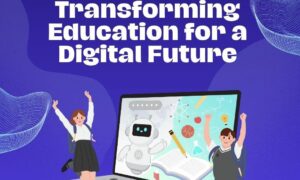Are you ready to unlock the secrets of educational technology and revolutionize your teaching game? Look no further! Welcome to our comprehensive guide that will demystify all things edtech. Whether you’re a seasoned educator or just starting out, this blog post is your ultimate roadmap to understanding and harnessing the power of educational technology in today’s digital age. Get ready for an exciting journey full of innovative tools, effective strategies, and endless possibilities.
Introduction:
In today’s fast-paced and rapidly evolving world, the role of technology in education has become increasingly important. As classrooms and learning environments continue to be impacted by technological advancements, educational technology (also known as EdTech) has emerged as a key tool in enhancing teaching and learning practices.
The Growing Importance of Educational Technology:
There are several factors that have contributed to the growing importance of educational technology in recent years. One major factor is the widespread availability and accessibility of technology. With the rise of digital devices such as laptops, tablets, and smartphones, students now have access to a wide range of resources and information at their fingertips. This has expanded the possibilities for incorporating technology into classroom instruction.
Furthermore, traditional methods of teaching and learning are being challenged by a new generation of tech-savvy students who are accustomed to using digital tools in their everyday lives. These students are often more engaged and motivated when using technology for educational purposes, making it an effective tool for increasing student participation and interest in learning.
Another significant factor driving the importance of educational technology is its potential to enhance instructional strategies. With various applications, software programs, online platforms, virtual reality tools, and other forms of EdTech available, teachers can design more interactive lessons that cater to different learning styles. This personalized approach promotes better comprehension and retention among students.
What is educational technology?
Educational technology, also known as EdTech, is the use of technological tools and resources to enhance teaching and learning experiences. It encompasses a wide range of digital devices, software applications, and online platforms that are specifically designed for educational purposes.
The concept of educational technology has been around since the 1920s, when films were used in classrooms as instructional aids. However, with the rapid advancements in technology over the years, its scope and impact on education have greatly expanded.
Today, educational technology plays a crucial role in modern-day classrooms by providing teachers and students with innovative ways to engage with course material and collaborate with one another. It has become an integral part of education systems worldwide, from elementary schools to universities.
Types of Educational Technology
There are various types of educational technology that can be classified based on their purpose or function. Some common types include:
1. Learning Management Systems (LMS): A learning management system is a software application that helps educators manage course content, assessments, grades, communication with students, and other administrative tasks. Popular examples include Canvas, Blackboard Learn, and Google Classroom.
2. Online Learning Platforms: These are web-based platforms that offer online courses or training programs for learners at any time or place they choose. Examples include Coursera, Udemy, and Khan Academy.
3. Augmented Reality (AR) and Virtual Reality (VR): AR involves adding digital elements to real-world environments, while VR offers immersive experiences through computer-generated simulations.
Definition and History of Educational Technology:
Educational technology, also known as EdTech, is the use of technology to enhance teaching and learning processes in education. It encompasses a wide range of tools, techniques, and strategies that are designed to improve the overall educational experience for students and educators alike.
The history of educational technology dates back to the early 20th century, when audio-visual aids like films, radio, and television were used in classrooms. However, it wasn’t until the late 1970s and early 1980s that computers began to be integrated into education. With the advent of personal computers, educational software programs were developed that allowed students to learn at their own pace and provided interactive learning experiences.
In recent years, there has been a significant increase in the use of digital devices such as laptops, tablets, smartphones, and other mobile devices in education. This has further expanded the scope of educational technology, with various tools and platforms being developed specifically for online or blended learning environments.
Today’s definition of educational technology goes beyond just hardware and software tools. It includes a wide range of digital resources, such as websites, virtual reality simulations, online courses, learning management systems (LMS), social media platforms, gamification elements, and more. These resources are constantly evolving with advancements in technology to meet the ever-changing needs of learners.
Common Misconceptions
Educational technology is a constantly evolving field, and with that come many misconceptions and misunderstandings. In this section, we will address some of the common myths and misconceptions surrounding educational technology.
1: Educational technology is just about using computers in the classroom.
One of the biggest misconceptions about educational technology is that it solely revolves around using computers in the classroom. While technology has certainly become an integral part of modern education, it encompasses much more than just computers. Educational technology includes a wide range of tools and resources, such as interactive whiteboards, mobile devices, online learning platforms, virtual reality, gamification, and more. It also covers various forms of media, such as videos, podcasts, animations, and simulations. The use of these tools aims to enhance teaching and learning processes rather than replace them.
2: Educational technology is only for tech-savvy teachers.
Another common misconception is that to effectively integrate educational technology into teaching practices, one needs to be highly skilled in using various technological tools. However, this couldn’t be further from the truth. While having technical skills can be beneficial for educators looking to incorporate technology into their lessons effectively, it is not a prerequisite for utilizing educational technology in the classroom. With proper training and support from school administrators or instructional technologists, even those who are less tech-savvy can successfully integrate educational technology into their teaching strategies.
3: Educational technology replaces traditional teaching methods.
The rise of digital tools does not mean that traditional teaching methods are no longer relevant. Educational technology is not meant to replace traditional teaching practices but rather to enhance and complement them. Technology can help make learning more engaging, interactive, and accessible for students, but it should not completely replace face-to-face interactions and hands-on learning experiences.
4: Educational technology is too expensive for schools to afford.
Many people believe that incorporating educational technology into the classroom requires a significant financial investment that many schools cannot afford. While some advanced technologies may come with a high price tag, there are also many affordable options available. For example, open-source software, free online resources, and low-cost devices like Chromebooks can provide effective educational technology solutions without breaking the bank. Additionally, many schools receive funding or grants specifically designated for technology integration.
5: Educational technology is a distraction in the classroom.
Some argue that the use of technology in the classroom leads to distractions and decreases student focus on learning. However, when used correctly, technology can actually increase engagement and focus in the classroom. By providing interactive and multimedia learning experiences, students are more likely to be actively involved in their education instead of passively sitting through lectures. It is essential for teachers to establish clear rules and expectations around technology use in order
Benefits of Using Educational Technology in the Classroom
There are numerous benefits to incorporating educational technology in the classroom. From increasing student engagement to improving learning outcomes, this innovative approach has a positive impact on both students and educators. In this section, we will delve deeper into the specific advantages of using educational technology in the classroom.
1. Enhanced Learning Experience
Educational technology allows for a more personalized and interactive learning experience for students. With access to a variety of multimedia resources, such as videos, simulations, and games, students can engage with the material in different ways that cater to their individual learning styles. This not only makes learning more enjoyable but also helps students retain information better.
2. Improved Collaboration and Communication
Technology has made it easier than ever for students to collaborate and communicate with each other and their teachers. With tools like virtual classrooms, online discussion boards, and group project platforms, students can work together on assignments regardless of their physical location. This fosters teamwork skills and encourages creativity as students learn from each other’s perspectives.
3. Access to a Wealth of Information
The internet is an endless source of information that can greatly enrich a student’s education. Educational technology provides easy access to this wealth of information through various online resources, such as e-books, research databases, and educational websites. Students can broaden their knowledge beyond traditional textbooks and explore new topics that interest them.
Types of Educational Technology
There are various types of educational technology, or EdTech, that are revolutionizing the way we teach and learn. These technologies encompass a wide range of tools and platforms designed to enhance the learning experience, promote engagement, and improve academic outcomes. In this section, we will discuss some of the most common types of educational technology used in classrooms today.
1. Learning Management Systems (LMS)
Learning management systems are web-based platforms that provide a centralized location for managing course materials, assignments, discussions, grades, and more. LMSs allow teachers to create an online classroom where students can access course materials from any device with internet access. Some popular LMSs include Canvas, Blackboard, and Moodle.
2. Digital Content
Digital content refers to any educational material that is available online or through digital devices, such as e-books, interactive textbooks, videos, podcasts, simulations, and games. This type of educational technology allows for personalized learning experiences by providing students with engaging and interactive content that can be accessed anytime and anywhere.
3. Collaborative Tools
Collaborative tools facilitate communication and collaboration among students and between teachers and students. Examples include video conferencing software like Zoom or Google Meet for virtual meetings or group work; project management tools like Trello or Asana for organizing group projects; and collaborative document editing platforms like Google Docs or Microsoft Teams.
Implementing Educational Technology in the Classroom
The implementation of educational technology in the classroom has been a hot topic in the education world for many years now. With the advancement of technology, it has become increasingly important to incorporate it into our teaching methods to prepare students for the digital age. However, implementing educational technology in the classroom can seem like a daunting task for teachers who are not familiar with it. In this section, we will discuss the steps and strategies that educators can use to effectively integrate educational technology into their classrooms.
1. Define your goals and objectives:
Before incorporating any new technology into your curriculum, it is crucial to have a clear understanding of your goals and objectives. What do you want your students to achieve through this technology? Will it enhance their learning experience or make it more efficient? Having a clear goal in mind will help you choose the right tools and ensure their successful integration into your lessons.
2. Research and select appropriate tools:
With an abundance of educational technology tools available, it can be overwhelming to determine which ones are most suitable for your classroom needs. Therefore, conducting thorough research on different options is key before making any purchases. Consider factors such as cost, compatibility with existing devices or software, ease of use, and potential benefits for student learning outcomes.
3. Provide training and support:
Once you have selected the appropriate tools for your classroom, providing proper training and support for both teachers and students is essential. Teachers need to feel confident in using these technologies before introducing them to their students.
Conclsion
Educational technology is a constantly evolving field that combines principles of education and technology to enhance learning experiences. It aims to improve teaching and learning by using various forms of technology, such as computers, mobile devices, and online platforms. With the rapid advancements in technology, educational technology plays a crucial role in modern education.



































